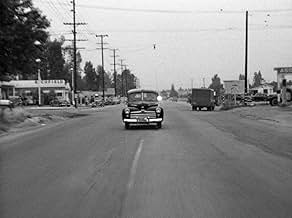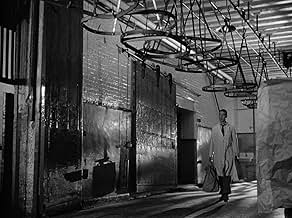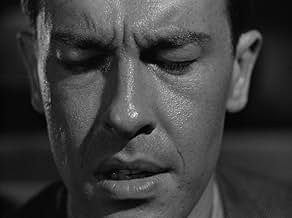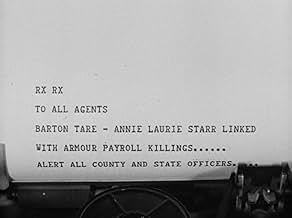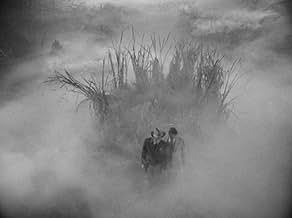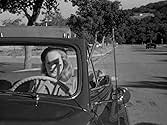AVALIAÇÃO DA IMDb
7,6/10
16 mil
SUA AVALIAÇÃO
Dois jovens perturbados liberam seu fascínio por armas em uma onda de crimes.Dois jovens perturbados liberam seu fascínio por armas em uma onda de crimes.Dois jovens perturbados liberam seu fascínio por armas em uma onda de crimes.
- Direção
- Roteiristas
- Artistas
- Prêmios
- 1 vitória no total
Russ Tamblyn
- Bart Tare (age 14)
- (as Rusty Tamblyn)
David Bair
- Dave Allister (child)
- (as Dave Bair)
Frances Irvin
- Danceland Singer
- (as Frances Irwin)
Avaliações em destaque
Peggy Cummins is the epitome of the bad dame.....in a word, terrific. The casting of this British actress was probably chancy for director Lewis but he hit paydirt. She comes across as a woman who wants it all and doesn't care how she gets it. Besides, she like to kill and wants to do "Just one more job." The choice of John Dall for the male lead was even more chancy. Dall, a stage actor, certainly wasn't very masculine and his acting revealed his stage background. But, again, Lewis hit the jackpot since it made the control that Cummins had over him even more believable.
The story has already been discussed on these boards so I won't repeat it except to say that it moves along at a rapid pace and keeps you enthralled from the beginning (well, not quite. Forget the sappy prologue and get right to the story.) A lot has been said about the one shot (from the back seat of the car) bank robbery but it is dynamite. It is said that Dall and Cummins' dialogue is improvised and that when you hear someone shout" The bank has been robbed", it is an actual pedestrian who did not know that a movie was being made. Now that's realism.
This little B thriller is as good as it gets and belongs right up there with "Detour", the gem of low-budget films. Enjoy!!!!!!!!!
The story has already been discussed on these boards so I won't repeat it except to say that it moves along at a rapid pace and keeps you enthralled from the beginning (well, not quite. Forget the sappy prologue and get right to the story.) A lot has been said about the one shot (from the back seat of the car) bank robbery but it is dynamite. It is said that Dall and Cummins' dialogue is improvised and that when you hear someone shout" The bank has been robbed", it is an actual pedestrian who did not know that a movie was being made. Now that's realism.
This little B thriller is as good as it gets and belongs right up there with "Detour", the gem of low-budget films. Enjoy!!!!!!!!!
No need to echo consensus points or plot details after a hundred or so reviews.
Yes indeed, much has been written about Lewis's little gem and deservedly so. What I get from it is how trapped Bart (Dall) is by forces he neither understands nor controls, until it's too late. On one hand there's Annie Laurie Starr (Cummins) whose raw sexuality is about as subtle as Mae West on aphrodisiacs. On the other, is Bart's natural talent with guns, the only thing he professes to be good at. So when the camera pans up from Laurie's thighs to the twirling six-shooters in the carny sideshow, Bart's in some kind of NRA heaven.
Then after he shoots out her last flame to show who's gun boss, their betrothal is sealed. At this point, they could retire to a Remington plant somewhere to live out conventional lives, except for one problem--- Laurie gets turned on by violence, especially with a revolver, while Bart's a converted pacifist, allergic to killing anything. So the problem is if Bart wants some of Laurie's white-hot sex, he's got to collaborate on her life of crime. Poor Bart, he'd like to be just another married couple, but temptress Laurie is just too much for his confusion. Plus, it's not a ring that bonds them, it's two clutching hands on a revolver that seals their love. For Bart, it's a spell he can't break until the mist finally swallows them both.
No doubt about it, Lewis has concocted a visual masterpiece that frames the story perfectly. However, I'm still wondering how Bart can shoot out a cop's tire through a glass pane without breaking it. Oh well, no movie's perfect.
Yes indeed, much has been written about Lewis's little gem and deservedly so. What I get from it is how trapped Bart (Dall) is by forces he neither understands nor controls, until it's too late. On one hand there's Annie Laurie Starr (Cummins) whose raw sexuality is about as subtle as Mae West on aphrodisiacs. On the other, is Bart's natural talent with guns, the only thing he professes to be good at. So when the camera pans up from Laurie's thighs to the twirling six-shooters in the carny sideshow, Bart's in some kind of NRA heaven.
Then after he shoots out her last flame to show who's gun boss, their betrothal is sealed. At this point, they could retire to a Remington plant somewhere to live out conventional lives, except for one problem--- Laurie gets turned on by violence, especially with a revolver, while Bart's a converted pacifist, allergic to killing anything. So the problem is if Bart wants some of Laurie's white-hot sex, he's got to collaborate on her life of crime. Poor Bart, he'd like to be just another married couple, but temptress Laurie is just too much for his confusion. Plus, it's not a ring that bonds them, it's two clutching hands on a revolver that seals their love. For Bart, it's a spell he can't break until the mist finally swallows them both.
No doubt about it, Lewis has concocted a visual masterpiece that frames the story perfectly. However, I'm still wondering how Bart can shoot out a cop's tire through a glass pane without breaking it. Oh well, no movie's perfect.
The original title of "Gun Crazy" was "Deadly Is the Female," and they ain't kidding. If you thought Faye Dunaway's Bonnie Parker was the more ruthless member of the crime duo that gave Arthur Penn's 1967 film its name, wait till you get a load of Peggy Cummins's Annie in this little known cheapie from 1949. I wouldn't want to get on this woman's bad side; she can shoot cigarettes out of people's mouths, for God's sake.
"Gun Crazy" is such an obvious influence on Penn's "Bonnie and Clyde" that I can't believe the later film doesn't credit it directly. Though the 1949 film is based on a short story that appeared in the "Saturday Evening Post" and the 1967 film worked with an original screenplay, both films could have been adapted from the same source. They portray the Annie/Bonnie character as bored and restless, turned on by the thought of crime and by a manly man who can really use his "gun." The Bart/Clyde character is tickled by the idea of being a virile stud in the eyes of his lover, but is ultimately too sensitive for the life they choose. And both films do a good job of portraying the desperation that plagues both couples, the isolation and loneliness they create for themselves and can never break out of, and the ultimate futility of their actions, since the "law" is going to catch up with them sooner or later.
Peggy Cummins is really good in this. I don't know what else she's been in, but her baby-doll voice creates an effective contrast to her colder-than-ice attitude. She's crooning into her lover's ear one minute and itching to kill someone the next. And you have to dig those French-inspired fashions that would cause a sensation nearly 20 years later when Dunaway donned them again for Penn's film.
I thought John Dall was at first odd casting for the role of Bart. Annie is supposed to think of him as a man's man, and Dall, with his willowy physique and gentle mannerisms is far from that. But then when we realize that he's at heart really too gentle for the life he and Annie have chosen for themselves, his casting makes sense.
There are some small touches to this film that really add to its immediacy and realism. I loved the scenes of Annie and Bart driving to and from their heist jobs, shot from the back seat of the car as if we are a member of their gang. They have really funny and natural banter back and forth about where to park, etc. which I have to believe was improvised to some extent. The ending of the film, a face off in a creepy swamp, is eerie, and there's a small twist in the last seconds of the film that might be easy to miss but may give you some things to think about if you catch it.
It's interesting, and rather depressing, that one of the main themes of this film is the obsession with guns and violence that pervaded the country nearly 60 years ago, and here we are a handful of wars later, still dragging around the same old obsessions. Michael Moore's recent documentary "Bowling for Columbine" could have just as easily been called "Gun Crazy," if that title weren't already taken by this forgotten little blast of a movie.
Grade: A-
"Gun Crazy" is such an obvious influence on Penn's "Bonnie and Clyde" that I can't believe the later film doesn't credit it directly. Though the 1949 film is based on a short story that appeared in the "Saturday Evening Post" and the 1967 film worked with an original screenplay, both films could have been adapted from the same source. They portray the Annie/Bonnie character as bored and restless, turned on by the thought of crime and by a manly man who can really use his "gun." The Bart/Clyde character is tickled by the idea of being a virile stud in the eyes of his lover, but is ultimately too sensitive for the life they choose. And both films do a good job of portraying the desperation that plagues both couples, the isolation and loneliness they create for themselves and can never break out of, and the ultimate futility of their actions, since the "law" is going to catch up with them sooner or later.
Peggy Cummins is really good in this. I don't know what else she's been in, but her baby-doll voice creates an effective contrast to her colder-than-ice attitude. She's crooning into her lover's ear one minute and itching to kill someone the next. And you have to dig those French-inspired fashions that would cause a sensation nearly 20 years later when Dunaway donned them again for Penn's film.
I thought John Dall was at first odd casting for the role of Bart. Annie is supposed to think of him as a man's man, and Dall, with his willowy physique and gentle mannerisms is far from that. But then when we realize that he's at heart really too gentle for the life he and Annie have chosen for themselves, his casting makes sense.
There are some small touches to this film that really add to its immediacy and realism. I loved the scenes of Annie and Bart driving to and from their heist jobs, shot from the back seat of the car as if we are a member of their gang. They have really funny and natural banter back and forth about where to park, etc. which I have to believe was improvised to some extent. The ending of the film, a face off in a creepy swamp, is eerie, and there's a small twist in the last seconds of the film that might be easy to miss but may give you some things to think about if you catch it.
It's interesting, and rather depressing, that one of the main themes of this film is the obsession with guns and violence that pervaded the country nearly 60 years ago, and here we are a handful of wars later, still dragging around the same old obsessions. Michael Moore's recent documentary "Bowling for Columbine" could have just as easily been called "Gun Crazy," if that title weren't already taken by this forgotten little blast of a movie.
Grade: A-
I have long been a fan of Film Noir. I consider this film to be unique and one of the best. The first and only time I saw it in a theater was in 1949 when I was 14. It was titled "Gun Crazy". I thought it was great but it didn't receive rave reviews or last long in hometown theaters. I understand they renamed it "Deadly Is The Female" in 1950 for its release in England, reason being that co-star Peggy Cummins was British and emphasizing the female star would be better box-office.
In the years that passed I wanted to see it again but it didn't appear on TV or later on any videotape that I knew of. In the 1983 Richard Geer film "Breathless" there is a chase scene where he is trying to escape by way of the stage behind a movie screen. On that screen was playing what I immediately recognized as "Gun Crazy". Over the years since then I have continued to look for the movie but was unable to find it. Less than a month ago I found it on DVD and purchased an excellent copy. I found that the movie is just as good as I remember it.
The film is essentially a story of a boy named Bart Tare (Russ Tamblyn) who loves guns for sport but refuses to harm any living being with them. After stealing one from a local store, he is caught and sent to a reformatory. The story continues four reformatory years plus one army hitch later when an adult Bart (John Dall) is discharged. He and some friends go to a cheap carnival where he sees and immediately falls for a trick shot artist, Annie Laurie Starr (Peggy Cummins). He beats her in a shooting contest but is offered a job in the act rather than the prize he was supposed to win.
Bart is unaware of her dark past, which includes hints of prostitution and the murder of a man in St. Louis. After a showdown with the jealous carnival owner they run off together and get married. When their money runs out, Bart wants to get a job but Annie Laurie's mind runs in a different direction, armed robbery. Reluctantly, Bart gives in and they set off on a spree of low paying stickups. By this time, Bart is increasingly aware that Annie Laurie has homicidal tendencies that he is barely able to keep under control. They plan a big-time robbery during which she kills two people without his knowledge. The rest of the movie deals with their flight from justice and ultimate payment for their crimes. In all, it is a classic scenario of "Bad Girl" leads a "Good Boy" into evil.
Personal opinion is that John Dall did a better acting job in this movie than he did in "Rope". In a bit of self-analysis I must admit that I have long been fascinated by "Wicked Women". This movie alone placed Peggy Cummins among my favorite "femme fatales", which included the queen of mean, Barbara Stanwyck, Marlene Dietrich, Beverly Michaels and other notables.
If you like classic film noir, it is a good movie to remember and see again.
In the years that passed I wanted to see it again but it didn't appear on TV or later on any videotape that I knew of. In the 1983 Richard Geer film "Breathless" there is a chase scene where he is trying to escape by way of the stage behind a movie screen. On that screen was playing what I immediately recognized as "Gun Crazy". Over the years since then I have continued to look for the movie but was unable to find it. Less than a month ago I found it on DVD and purchased an excellent copy. I found that the movie is just as good as I remember it.
The film is essentially a story of a boy named Bart Tare (Russ Tamblyn) who loves guns for sport but refuses to harm any living being with them. After stealing one from a local store, he is caught and sent to a reformatory. The story continues four reformatory years plus one army hitch later when an adult Bart (John Dall) is discharged. He and some friends go to a cheap carnival where he sees and immediately falls for a trick shot artist, Annie Laurie Starr (Peggy Cummins). He beats her in a shooting contest but is offered a job in the act rather than the prize he was supposed to win.
Bart is unaware of her dark past, which includes hints of prostitution and the murder of a man in St. Louis. After a showdown with the jealous carnival owner they run off together and get married. When their money runs out, Bart wants to get a job but Annie Laurie's mind runs in a different direction, armed robbery. Reluctantly, Bart gives in and they set off on a spree of low paying stickups. By this time, Bart is increasingly aware that Annie Laurie has homicidal tendencies that he is barely able to keep under control. They plan a big-time robbery during which she kills two people without his knowledge. The rest of the movie deals with their flight from justice and ultimate payment for their crimes. In all, it is a classic scenario of "Bad Girl" leads a "Good Boy" into evil.
Personal opinion is that John Dall did a better acting job in this movie than he did in "Rope". In a bit of self-analysis I must admit that I have long been fascinated by "Wicked Women". This movie alone placed Peggy Cummins among my favorite "femme fatales", which included the queen of mean, Barbara Stanwyck, Marlene Dietrich, Beverly Michaels and other notables.
If you like classic film noir, it is a good movie to remember and see again.
At the time, such an idea of having the heroes being the criminals was un-heard of, but Joseph H. Lewis's film deservedly has its claim of being the little B-movie that could (forgive the mechanical analogy) by inspiring the French new-wave and other films like Bonnie & Clyde. The idea of having a tragic love story pitted in the middle of noir facade was also seen in the equally powerful low-budget They Live by Night. But while Nicholas Ray's film is more impressive on its emotional stakes, Gun Crazy rakes up points for some of its technical achievements. The style implemented by Lewis and DP Russel Harlan (also responsible for the great photography in Red River) adds excitement to the more suspenseful, even violent scenes, and adds some sentiment to the softer ones involving the couple. And I love the scenes where young Bart can't seem to put away his fascination with guns.
Bart (John Dall) starts off as a boy, and in some of these early scenes (some of the best in the film), we see how he is changed by an unfortunate act, and then the story skips ahead suddenly. Now Bart is an adult, out of the army, and gets re-introduced to guns once he meets his soon-to-be love and partner in crime, Annie, played by Peggy Cummins. From there, after getting married and needing (or rather wanting) money, they start robbing banks across country, but soon to meet their demise. But more than anything, the film's focus isn't one where 'crime doesn't pay' or some kind of typical, of-the-period nonsense. Like the Asphalt Jungle, we're given these conflicted, emotional beings who may meet their own ends with each other before the law. And in the film-noir tradition, it's the woman here who will act as a main catalyst for the end of them. It's psychological side of danger, pathological lies, and the pattern of a downward spiral in having to commit violent acts (even un-intentionally), becomes what really pulls in the viewer into the picture, aside from the more loose, on-location 'real' style and interesting camera-work.
Under more 'B-movie' conditions, Lewis sneaks in plenty of chances to look past some of the more cardboard cut-out forms the characters could have been. The acting by the leads is also very good, the script mostly by Dalton Trumbo is one of his best, and both understand how one reflects the other. Cummins is perfect in her part, even if Dall isn't quite as much a stand-out (though, of course, he's the sap to her more wicked side). Also out of the script comes cool lines like the one listed in the summary. It's a notch above many other B-noirs of the period, and should be seen by most serious fans of the 'mood' that came in noir films. A bit cynical, fatalistic to be sure, but it's smart too.
Bart (John Dall) starts off as a boy, and in some of these early scenes (some of the best in the film), we see how he is changed by an unfortunate act, and then the story skips ahead suddenly. Now Bart is an adult, out of the army, and gets re-introduced to guns once he meets his soon-to-be love and partner in crime, Annie, played by Peggy Cummins. From there, after getting married and needing (or rather wanting) money, they start robbing banks across country, but soon to meet their demise. But more than anything, the film's focus isn't one where 'crime doesn't pay' or some kind of typical, of-the-period nonsense. Like the Asphalt Jungle, we're given these conflicted, emotional beings who may meet their own ends with each other before the law. And in the film-noir tradition, it's the woman here who will act as a main catalyst for the end of them. It's psychological side of danger, pathological lies, and the pattern of a downward spiral in having to commit violent acts (even un-intentionally), becomes what really pulls in the viewer into the picture, aside from the more loose, on-location 'real' style and interesting camera-work.
Under more 'B-movie' conditions, Lewis sneaks in plenty of chances to look past some of the more cardboard cut-out forms the characters could have been. The acting by the leads is also very good, the script mostly by Dalton Trumbo is one of his best, and both understand how one reflects the other. Cummins is perfect in her part, even if Dall isn't quite as much a stand-out (though, of course, he's the sap to her more wicked side). Also out of the script comes cool lines like the one listed in the summary. It's a notch above many other B-noirs of the period, and should be seen by most serious fans of the 'mood' that came in noir films. A bit cynical, fatalistic to be sure, but it's smart too.
Você sabia?
- CuriosidadesThe bank heist sequence was done entirely in one take, with no one other than the principal actors and people inside the bank aware that a movie was being filmed. When John Dall as Bart Tare says, "I hope we find a parking space," he really meant it, as there was no guarantee that there would be one. In addition, at the end of the sequence someone in the background screams that there's been a bank robbery - this was a bystander who saw the filming and assumed the worst.
- Erros de gravaçãoAnyone who has done even a little mountain hiking knows that alpine marshes and swamps are quite common, especially in California. All it takes is a shallow depression that fills seasonally with snow melt. Many (not all) alpine lakes have adjacent marshy areas. There is no suggestion in the film that the protagonists are at an altitude sufficient for permanent snow cover. Consequently, movement into a marshy area for the final scene is not a goof in any sense.
- ConexõesEdited into Cidade Tenebrosa (1953)
Principais escolhas
Faça login para avaliar e ver a lista de recomendações personalizadas
- How long is Gun Crazy?Fornecido pela Alexa
Detalhes
- Data de lançamento
- País de origem
- Centrais de atendimento oficiais
- Idioma
- Também conhecido como
- Muerte al amanecer
- Locações de filme
- 2300 E Olympic Blvd, Los Angeles, Califórnia, EUA(Armour meatpacking plant)
- Empresas de produção
- Consulte mais créditos da empresa na IMDbPro
Bilheteria
- Orçamento
- US$ 400.000 (estimativa)
- Faturamento bruto mundial
- US$ 17.322
- Tempo de duração1 hora 27 minutos
- Cor
- Proporção
- 1.37 : 1
Contribua para esta página
Sugerir uma alteração ou adicionar conteúdo ausente

Principal brecha
By what name was Mortalmente Perigosa (1950) officially released in India in English?
Responda



